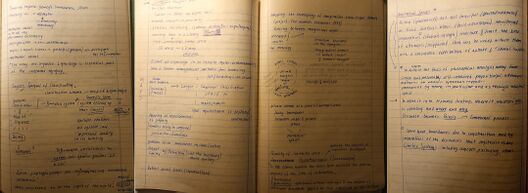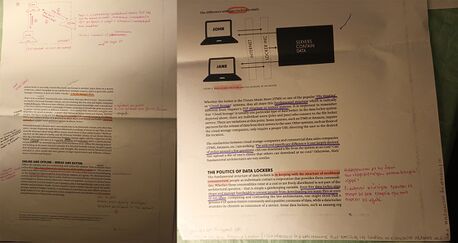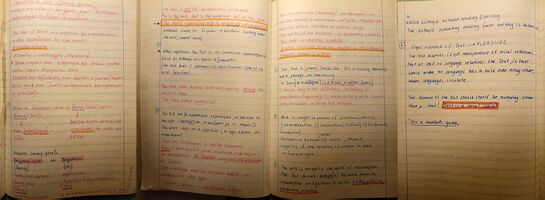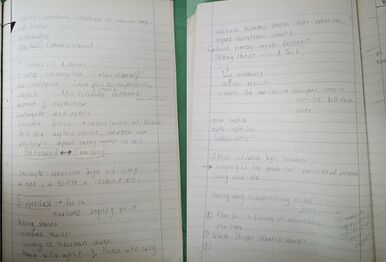The Methods, the Readers, the Texts, the Sayings: Difference between revisions
No edit summary |
|||
| Line 137: | Line 137: | ||
====Hyperworld | Ted Nelson==== | ====Hyperworld | Ted Nelson==== | ||
==== Thinking in Boxes==== | ==== Paper Machines (Thinking in Boxes) | Markus Krajewski==== | ||
''Kleist ’ s idea is that communication partners need a catalyst to attain clarity about the knowledge to be expressed. What does the mere presence of an interlocutor achieve? '''“ The midwifery of thought ”''' — a term Kleist borrowed from Kant. Without a counterpart, intellectual bankruptcy looms, as in the case of Heine ’ s friend G., but with a partner, wealth beckons. It is no coincidence that early collections of analects and excerpts from all readings date from the same era as the paper banks of the sixteenth century.'' | |||
''According to Kleist, the <big>human face serves as a sufficient source for inspiration;</big> a look that conveys comprehension of a half-expressed thought is suffi cient. One could assume that looking at wooden drawers is hardly inspiring. However, substitute the “ interface ” between person and appara-tus for the “ human face ” — and substitute for the simple word “ gaze ” the word “ brush. ” For it is the light touch of index cards, the interplay with the silent interlocutor, that gives birth to a thought, prompting the inter-locutor to actually speak and provide “ witty responses ” after all, to use Kleist ’ s phrase. The box of index cards offers an interface that is more than just a stimulating sight, as the apparatus, upon the lightest touch, delivers keywords that stimulate the protagonist to further production of thought. Thus, a silent counterpart can grow into an actual interlocutor. The fact that the keywords offered seem by no means arbitrary is guaranteed by a widespread net of cross-references, for both partners. Bit by bit, during the course of their interaction, connections accumulate in the apparatus as a “ kind of second memory. ” 70 And this second memory gains a certain amount of independence if it intervenes in the thought process of its thoughtful user more thoroughly than Kleist suggested.'' | |||
====Exploratory Programming: Calculating and using Jupyter Notebook==== | ====Exploratory Programming: Calculating and using Jupyter Notebook==== | ||
Revision as of 15:52, 15 October 2022
W H Y | W H A T | H O W
Bootleg Library
https://hub.xpub.nl/bootleglibrary/shelf/96
Mapping Beyond Dewey's Boundaries: Constructing Classificatory Space for Marginalised Knowledge Domains | Hope A. Olson
"Moving from silence into speech is for the oppressed the colonised, the exploited in those who stand and struggle side by side a gesture of defiance that heeals that makes new life new growth possible. it is the act of speech, stalking back that is no mere gesture of my words that is the expression of our movement from object to subject the "liberated voice.", Bell Hooks
The way we organize knowledge is essential part of the cultural memory
Sayers " manual of classification"
Classification scheme---> map of knowledge
Cornell's idea-- boundless system system defined by the limits post-structuralist
Multiple realities no system can represent reality in it's totallity
Η ταξινόμηση καταδεικνύει τη σχέση ενός κλάδου γνώσης με έναν άλλο
Σχέση χαρτογράφησης και ταξινόμησης ως κοινωνικές κατασκευές!
Maps consider to be the limits of the world
Distort all knowledge is infinite multi diamonds dimensionality into ε linear arrangement suitable for browsing list locations on shelves
Mapping as representations of property terrains belong someone
Quality of constructed space
Is the extent to which the index term reflects the precise content of the item of information. Pigeon holes performed without reference to the subjects of particular documents based on the structure of the system in comparison with co extensiveness which is dazed on the subjects of individual documents.
Rhetorical spaces(to deflect the folks Sofia Sophie call analysis away from singing and presumably self-contained propositional you terence's pronounced by no one in particular and as though neutral space)
Fictive φανταστικός but not fanciful φαντασιόπληκτος or fixed locations whose tacit territorial imperative structure and limited the kind of answers that can be voiced within them with a reasonable expectation of uptake and coral support.
--> to move it into textured locations where it matters who is speaking and where and why discourse becomes Poiesis (communal process)
Space have boundaries due to construction by imperatives of the discourses that construct them.
Limited systems including concepts excluding others.
This apparently neutral space is like postmodern theorist Henri Lefebvre transparent space which denies the existence of anything excluded from snapping because it appears to be all there is. "Transparent" space is the illusion that location is neutral' that mapping territory can be a 'true' representation of some a sense of reality as Brooks suggests. Space husband Aries and always includes and excludes something it cannot be neutral. Making the exclusions visible means identifying the space boundaries to allow recognition of what is outside those boundaries. It is identifying the implied opposite of a deconstructive binary opposition. It shows the constructed nature of the space. It moves the discourse into Texas locations word mothers who is speaking and where and why and where such monitoring bears directly upon the possibility of knowledge claims.
Poiesis a way of presenting experience reality that remains and alters it in the process
Classification remakes and altars information by constructing a particular context for it. Gathering scattering and juxtaposing topics in relation to each other.
The creation of classification creates the space in which some knowledges are central and others are peripheral.
Radical Tactics of the Offline Library (It's a numbers game) | Henry Warwick
Image Music Text (From Work to Text) | Ronald Barthes
Donna Haraway's response to Ursula Le Guin's Carrier Bag
Moya Davey, Fifty minutes
https://www.ubu.com/film/davey_50.html
Fugitive Libaries | Shannon Mattern
The Undercommons: Fugitive Planning & Black Study
She Unnames Them | Ursula K. Le Guin
Ursula K. Le Guin 1986 The Carrier Bag Theory of Fiction
Mutual Aid | Peter Kropotkin (1912)
Hyperworld | Ted Nelson
Paper Machines (Thinking in Boxes) | Markus Krajewski
Kleist ’ s idea is that communication partners need a catalyst to attain clarity about the knowledge to be expressed. What does the mere presence of an interlocutor achieve? “ The midwifery of thought ” — a term Kleist borrowed from Kant. Without a counterpart, intellectual bankruptcy looms, as in the case of Heine ’ s friend G., but with a partner, wealth beckons. It is no coincidence that early collections of analects and excerpts from all readings date from the same era as the paper banks of the sixteenth century.
According to Kleist, the human face serves as a sufficient source for inspiration; a look that conveys comprehension of a half-expressed thought is suffi cient. One could assume that looking at wooden drawers is hardly inspiring. However, substitute the “ interface ” between person and appara-tus for the “ human face ” — and substitute for the simple word “ gaze ” the word “ brush. ” For it is the light touch of index cards, the interplay with the silent interlocutor, that gives birth to a thought, prompting the inter-locutor to actually speak and provide “ witty responses ” after all, to use Kleist ’ s phrase. The box of index cards offers an interface that is more than just a stimulating sight, as the apparatus, upon the lightest touch, delivers keywords that stimulate the protagonist to further production of thought. Thus, a silent counterpart can grow into an actual interlocutor. The fact that the keywords offered seem by no means arbitrary is guaranteed by a widespread net of cross-references, for both partners. Bit by bit, during the course of their interaction, connections accumulate in the apparatus as a “ kind of second memory. ” 70 And this second memory gains a certain amount of independence if it intervenes in the thought process of its thoughtful user more thoroughly than Kleist suggested.
Exploratory Programming: Calculating and using Jupyter Notebook
Un-/Learning Archives in the Age of the Sixth Extinction
https://wholelife.hkw.de/un-learning-archives-in-the-age-of-the-sixth-extinction/
"In thinking more about gardens as overlapping sites of history, legacy, and testimony, sustainable gardening systems, such as seed keeping and perennial plantings become metaphorical approaches to reconnecting with distant relatives and beloved homelands. Gardening is important, but seed saving is crucial. Gardeners frequently save seeds as an attempt to grow a better crop the next year, save money, and in order to trade with others. However, a seed holds more than its genetic logic. Seeds hold memory. For many, seeds are vessels for belief and hope.
Over the years, the gardener maintains a reciprocal exchange with plants—cultivating an intimate relationship to the earth, preserving memories of years before, and observing their own personal transformation in the process. How can gardening serve as a reminder of one’s cultural heritage and identity? How can seed saving make stories and traditions more widely known? How can seeds bring invisible legacies to the forefront? Seeds are relatives. They prompt discussions on creation, belonging, and heritage. Seeds are a living archive and therefore ask us how archives can become more participatory and serve as a transmission of history rather than being frozen or fixed. Seeds communicate physical, historical, and cultural relationships as they relate to agriculture. Some of us collect and carry seeds in an attempt to cultivate our “homelands” elsewhere. There is a growing inter-generational movement of Indigenous peoples who are leading the rematriation of seeds in order to repair and heal after more than 500 years of separation, removal, and colonization. Seeds are coming home."
"Even if academia reframes white settler worldviews away from discrete models of expertise toward collective systems and knowledge production as planetary, what now? Even if we shift from white settler demands anchored in colonial-capitalist conquest and extraction toward responsibility to the environment and sustaining earth’s ecosystems through understanding the planet as an interdependent, holistic system, how then, to preserve Earth as an archive without getting lost in its imitations, either by virtual worlds or by terraforming other planets to its likeness? How do we avoid typologies that oversimplify lived experiences? How do these things become urgent—rather than conceptual—in climate catastrophe, in the apocalypse?
So, then, for the purposes of this workshop outcome, what would it mean to consider an archive as an antidote to extinction? Or— again—what might it mean to feel or read the planet as archive? What kind of (exploratory, conceptual, creative, practical) project is it to undertake the preservation of everything— to acknowledge that to preserve one thing we must preserve all things? What gets to be saved? Whose memory? For what future? What is the role of the earthly archive of human and more-than-human experiences when the future is this uncertain?"




